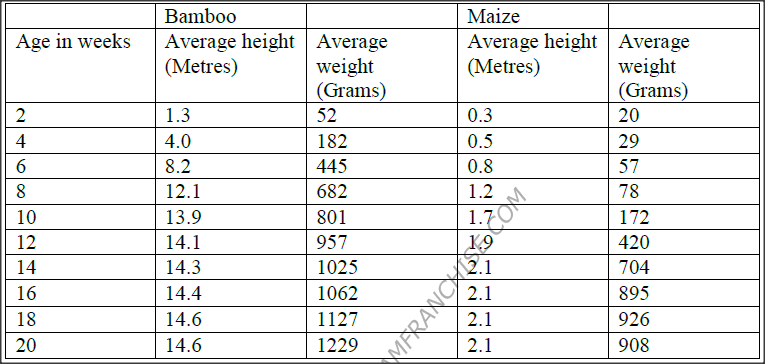K.C.S.E Biology Q & A - MODEL 1997PP1QN18
An experiment was carried out to determine the growth rates of bamboo and a variety of maize plants in two adjacent plots. The average height and average dry weight of plants from the two populations were determined over a period of twenty weeks. The data is as shown in the table below.
(a) Between which two weeks did the greatest increase in weight occur in
(b) Bamboo plants (ii) Maize plants (b) (i) Which of the two types of plants had a higher productivity by the end of the experiment (ii) Give a reason for your answer in (b) (i) above (c) Between weeks 14 and 18, the average height of the maize plants remained constant while average dry weight increased. Explain this observation (d) Suggest how the change in the average dry weight bamboo and maize Plants would have been at week 22 if the experiment was continued. (e) Why was it appropriate for this experiment to use (i) Dry weight instead of fresh weight (ii) Weight and height (f) Describe how the average height and weight of the plants were determined in this experiment. Average height Average dry Weight (g) Give a reason why secondary thickening does not occur in bamboo and maize plants
answers
(a) (i) Bamboo plants
4 and 6 (ii)Maize plants 12 and 14 (b) (i) Bamboo (ii) It had accumulated more weight and therefore greater dry weight (c) Maize plants have reached maturity/maximum height food being manufactured (in green parts); is utilized for growth storage primary in the cob. (d)Increase in weight – bamboo reject both increase/ decrease accept bamboo and maize increase/ decrease. (e) (i) Dry weight instead of fresh weight Fresh weight is dependant on the amount of water present in the plants and this fluctuates depending on environmental factors. (ii) Weight and height Both given a better measure of growth (f) Average height At every 2 weeks measure the height of samples of plants in each plot: Divide the total height by the number of plants in each of plot. Average dry weight Harvest the sample measure of the plants in each plot; dry to constant weight: And divide by the number of plants (g) Being monocots/ lack (Inter) fascicular cambium:
0 Comments
Leave a Reply. |
Archives
December 2024
Categories
All
TOPICSFORM 1
Form 2
Form 3
Form 4
|
Can't find what you are looking for? Don't worry, Use the Search Box Below.
|
Primary Resources
College Resources
|
Secondary Resources
|
Contact Us
Manyam Franchise
P.O Box 1189 - 40200 Kisii Tel: 0728 450 424 Tel: 0738 619 279 E-mail - sales@manyamfranchise.com |








 RSS Feed
RSS Feed

